A Coalitional Model Predictive Control for the Energy Efficiency of Next-Generation Cellular Networks
Abstract
:1. Introduction
2. Problem Description
2.1. Base Station Dynamics
2.2. Coalition Dynamics
2.3. Energy Consumption Model
2.4. Data Traffic Model
2.5. On-Grid Energy Consumption Optimization Problem
3. Control Methods
3.1. Coalitional MPC
| Algorithm 1: Coalitional MPC. |
Initial data:. Starting point:. Main program: for do if then 1: The upper control layer measures states and disturbances , . 2: The upper layer computes the set (Equation (10)) and solves Equation (11) subject to Equation (2) for each . Afterwards, the topology with the lowest cost is selected. 3: Send the new topology to the lower control layer. 4: Apply the first element of to coalition system (Equation (2)), for all . else 5: In the lower layer, each coalition solves Equation (11) subject to its dynamics and constraints. 6: Apply the first element of to coalition system (Equation (2)), and obtain , . end if 7: Set . end for |
3.2. Centralized and Decentralized MPC
3.3. Energy-Aware Heuristic
3.4. Best-Signal-Level Policy
4. Illustrative Examples
4.1. Case Studies
- An academic scenario with a set of base stations (one MBS and eight SCBSs), which is sophisticated enough to show the potential of the proposed method (see Figure 2a). The complexity of the association process is caused by the number of BSs and active users.
- A large scenario with a set of base stations (one MBS and 36 SCBSs), which represents the complexity of real problems (see Figure 2b). In this case, it is only possible to compare the proposed method with a heuristic approach.
4.2. Simulation Parameters
4.3. Disturbances
4.4. Key Performance Indicators
- Grid consumption (kWatts-hour).
- Reduction of grid consumption (%) in comparison with the best-signal level mechanism.
- Average stored energy (Watts-hour).
- Users served (%).
- Average transmission rate (%) in comparison with the best-signal level mechanism.
- Performance cost, which is defined as the sum of the accumulated stage cost over the simulation:
- Cooperation cost, which is defined as the sum of the cooperation cost over the simulation:with , where we recall that is the cost per active link, and denotes the number of enabled links in topology at time instant k.
4.5. Results and Discussion
4.5.1. Academic Scenario
4.5.2. Large Scenario
5. Conclusions
6. Materials and Methods
Author Contributions
Funding
Conflicts of Interest
Abbreviations
| BS | Base Station |
| SCBS | Small-cell Base Station |
| MBS | Macro-cell Base Station |
| LTE | Long-Term Evolution |
| MPC | Model Predictive Control |
| MILP | Mixed-Integer Linear Problem |
| NGCN | Next-Generation Cellular Network |
| HetNet | Heterogeneous Cellular Network |
| NHPP | Non-Homogeneous Poisson Process |
| HPP | Homogeneous Poisson Process |
| SINR | Signal-to-Interference-plus-Noise Ratio |
| RAN | Radio Access Network |
| ITU | International Telecommunication Union |
References
- CISCO. Cisco Annual Internet Report (2018–2023). Available online: https://www.cisco.com/c/en/us/solutions/collateral/executive-perspectives/annual-internet-report/white-paper-c11-741490.pdf (accessed on 11 September 2020).
- ITU. Recommendation ITU-T L.1380: Smart Energy Solution for Telecom Sites. Available online: https://www.itu.int/rec/T-REC-L.1380-201911-I/en (accessed on 1 December 2020).
- Huo, Y.; Dong, X.; Wei, X.; Yuen, M. Enabling Multi-Functional 5G and Beyond UserEquipment: A Survey and Tutorial. IEEE Access 2019, 7, 116975–117008. [Google Scholar] [CrossRef]
- Lubritto, C.; Petraglia, A.; Vetromile, C.; Curcuruto, S.; Logorelli, M.; Marsico, G.; D’Onofrio, A. Energy and environmental aspects of mobile communication systems. Energy 2011, 36, 1109–1114. [Google Scholar] [CrossRef] [Green Version]
- Hasan, Z.; Boostanimehr, H.; BhargavaGhazzai, V. Green Cellular Networks: A Survey, Some Research Issues and Challenges. IEEE Commun. Surv. Tutor. 2011, 13, 524–540. [Google Scholar] [CrossRef] [Green Version]
- CELTIC-NEXT. Artificial Intelligence for Green Networks (AI4GREEN). 2020. Available online: https://ai4green.celfinet.com/ (accessed on 11 September 2020).
- SCAVENGE. Sustainable Cellular Networks Harvesting Ambient Energy (SCAVENGE). 2019. Available online: http://www.scavenge.eu/ (accessed on 11 September 2020).
- Auer, G.; Giannini, V.; Desset, C.; Gódor, I.; Skillermark, P.; Olsson, M.; Imran, M.; Sabella, D.; Gonzalez, M.; Blume, O.; et al. How much energy is needed to run a wireless network? IEEE Wirel. Commun. 2011, 18, 40–49. [Google Scholar] [CrossRef]
- Fletscher, L.A.; Maestre, J.M.; Peroni, C.V. Coalitional Planning for Energy Efficiency of HetNets Powered by Hybrid Energy Sources. IEEE Trans. Veh. Technol. 2018, 1–13. [Google Scholar] [CrossRef]
- Suarez, L.; Nuaymi, L.; Bonnin, J. An overview and classification of research approaches in green wireless networks. EURASIP J. Wirel. Commun. Netw. 2012, 2012, 142. [Google Scholar] [CrossRef]
- Dhillon, H.; Li, Y.; Nuggehalli, P.; Pi, Z.; Andrews, J. Fundamentals of Heterogeneous Cellular Networks with Energy Harvesting. IEEE Trans. Wirel. Commun. 2014, 13, 2782–2797. [Google Scholar] [CrossRef]
- Gandotra, P.; Kumar, R.; Jain, S. Green Communication in Next Generation Cellular Networks: A Survey. IEEE Access 2017. [Google Scholar] [CrossRef]
- Morea, F.; Viciguerra, G.; Cucchi, D.; Valencia, C. Life cycle cost evaluation of off-grid PV-wind hybrid power systems. In Proceedings of the 29th International Telecommunications Energy Conference, Rome, Italy, 30 September–4 October 2007; IEEE: Piscataway, NJ, USA, 2007; pp. 439–441. [Google Scholar] [CrossRef]
- Marsan, M.; Bucalo, G.; Di Caro, A.; Meo, M.; Zhang, Y. Towards zero grid electricity networking: Powering BSs with renewable energy sources. In Proceedings of the 2013 IEEE International Conference on Communications Workshops (ICC), Budapest, Hungary, 9–13 June 2013; pp. 596–601. [Google Scholar] [CrossRef]
- Alsharif, M.; Nordin, R.; Ismail, M. Energy optimization of hybrid off-grid system for remote telecommunication base station deployment in Malasya. EURASIP J. Wirel. Commun. Netw. 2015, 2015, 64–79. [Google Scholar] [CrossRef] [Green Version]
- Piro, G.; Miozzo, M.; Forte, G.; Baldo, N.; Grieco, L.; Boggia, G.; Dini, P. HetNets Powered by Renewable Energy Sources: Sustainable Next-Generation Cellular Networks. Internet Comput. IEEE 2013, 17, 32–39. [Google Scholar] [CrossRef]
- Guruacharya, S.; Hossain, E. Self-Sustainability of Energy Harvesting Systems: Concept, Analysis, and Design. IEEE Trans. Green Commun. Netw. 2017, 2, 175–192. [Google Scholar] [CrossRef] [Green Version]
- Trabelsi, N.; Chen, S.; El-Azouzi, R.; Roullet, L.; Altman, E. User Association and Resource Allocation Optimization in LTE Cellular Networks. IEEE Trans. Netw. Serv. Manag. 2017, 14, 429–440. [Google Scholar] [CrossRef]
- Andrews, J.; Singh, S.; Ye, Q.; Lin, X.; Dhillon, H. An overview of load balancing in Hetnets: Old myths and open problems. IEEE Wirel. Commun. 2014, 21, 18–25. [Google Scholar] [CrossRef] [Green Version]
- Zhou, J.; Li, M.; Liu, L.; She, X.; Chen, L. Energy source aware target cell selection and coverage optimization for power saving in cellular networks. In Proceedings of the 2010 IEEE/ACM Int’l Conference on Green Computing and Communications & Int’l Conference on Cyber, Physical and Social Computing, Hangzhou, China, 18–20 December 2010; pp. 1–8. [Google Scholar] [CrossRef]
- Han, T.; Ansari, N. On Optimizing Green Energy Utilization for Cellular Networks with Hybrid Energy Supplies. IEEE Trans. Wirel. Commun. 2013, 12, 3872–3882. [Google Scholar] [CrossRef]
- Dantong, L.; Yue, C.; Kok, C.; Tiankui, Z.; Chengkang, P. Adaptive user association in HetNets with renewable energy powered base stations. In Proceedings of the 21st International Conference on Telecommunications (ICT), Lisbon, Portugal, 4–7 May 2014; pp. 93–97. [Google Scholar] [CrossRef]
- Silva, A.; Tembine, H.; Altman, E.; Debbah, M. Optimum and Equilibrium in Assignment Problems With Congestion: Mobile Terminals Association to Base Stations. IEEE Trans. Autom. Control 2013, 58, 2018–2031. [Google Scholar] [CrossRef] [Green Version]
- Liu, X.; Ansari, N. Dual-Battery Enabled Profit Driven User Association in Green Heterogeneous Cellular Networks. IEEE Trans. Green Commun. Netw. 2018, 2, 1002–1011. [Google Scholar] [CrossRef]
- Camacho, E.F.; Bordons, C. Model Predictive Control. Springer-Verlag: London, UK, 2007. [Google Scholar]
- Cea, M.; Goodwin, G.; Wigren, T. Model predictive zooming power control in future cellular systems under coarse quantization. In Proceedings of the IEEE Vehicular Technology Conference (VTC Fall)), Quebec City, QC, Canada, 3–6 September 2012. [Google Scholar] [CrossRef]
- Garcia, V.; Lebedev, N.; Gorce, J.M. Model predictive control for smooth distributed power adaptation. In Proceedings of the IEEE Wireless Communications and Networking Conference (WCNC), Paris, France, 1–4 April 2012. [Google Scholar] [CrossRef] [Green Version]
- Distributed Model Predictive Control Made Easy; Maestre, J.M.; Negenborn, R.R. (Eds.) Springer: Berlin/Heidelberg, Germany, 2014; Volume 69. [Google Scholar]
- Fele, F.; Maestre, J.M.; Camacho, E.F. Coalitional Control: Cooperative Game Theory and Control. IEEE Control Syst. 2017, 37, 53–69. [Google Scholar] [CrossRef]
- Fele, F.; Debada, E.; Maestre, J.M.; Camacho, E.F. Coalitional Control for Self-Organizing Agents. IEEE Trans. Autom. Control 2018. [Google Scholar] [CrossRef]
- Hassan, H.; Nuaymi, L.; Pelov, A. Classification of renewable energy scenarios and objectives for cellular networks. In Proceedings of the IEEE International Symposium on Personal, Indoor and Mobile Radio Communications, PIMRC, London, UK, 8–11 September 2013; pp. 2967–2972. [Google Scholar] [CrossRef]
- Fletscher, L.A.; Peroni, C.V.; Maestre, J.M. An assessment of different user–BS association policies for green HetNets in off-grid environments. Trans. Emerg. Telecommun. Technol. 2017, 28, 1–15. [Google Scholar] [CrossRef]
- Fletscher, L.A.; Suárez, L.A.; Grace, D.; Peroni, C.V.; Maestre, J.M. Energy-aware resource management in heterogeneous cellular networks with hybrid energy sources. IEEE Trans. Netw. Serv. Manag. 2018, 16, 279–293. [Google Scholar] [CrossRef]
- Masero, E.; Fletscher, L.A.; Maestre, J.M. A coalitional model predictive control approach for heterogeneous cellular networks. In Proceedings of the IEEE European Control Conference (ECC), Saint Petersburg, Russia, 12–15 May 2020; pp. 448–453. [Google Scholar]
- Han, T.; Ansari, N. A traffic load balancing framework for software-defined radio access networks powered by hybrid energy sources. IEEE/ACM Trans. Netw. 2016, 24, 1038–1051. [Google Scholar] [CrossRef] [Green Version]
- Kim, H.; de Veciana, G.; Yang, X.; Venkatachalam, M. Distributed α-Optimal User Association and Cell Load Balancing in Wireless Networks. IEEE/ACM Trans. Netw. 2012, 20, 177–190. [Google Scholar] [CrossRef]
- Lopez-Perez, D.; Guvenc, I.; Roche, G.; Kountouris, M.; Quek, T.; Zhang, J. Enhanced intercell interference coordination challenges in heterogeneous networks. IEEE Wirel. Commun. 2011, 18, 22–30. [Google Scholar] [CrossRef] [Green Version]
- Liu, D.; Chen, Y.; Chai, K.; Zhang, T.; Elkashlan, M. Two Dimensional Optimization on User Association and Green Energy Allocation for HetNets with Hybrid Energy Sources. IEEE Trans. Commun. 2015, 63, 4111–4124. [Google Scholar] [CrossRef]
- Yang, H.; Geraci, G.; Quek, T. Energy-Efficient Design of MIMO Heterogeneous Networks with Wireless Backhaul. IEEE Trans. Wirel. Commun. 2016, 15, 4914–4927. [Google Scholar] [CrossRef] [Green Version]
- Johnson, D.; Garey, M. Computers and Intractability: A Guide to the Theory of NP-Completeness, 1st ed.; Bell Telephone Laboratories, Incorporated: Murray Hill, NJ, USA, 1979. [Google Scholar]
- Andrews, J. Seven ways that Hetnets are a cellular paradigm shift. IEEE Commun. Mag. 2013, 51, 136–144. [Google Scholar] [CrossRef]
- Muros, F.J.; Maestre, J.M.; Algaba, E.; Alamo, T.; Camacho, E.F. Networked control design for coalitional schemes using game-theoretic methods. Automatica 2017, 78, 320–332. [Google Scholar] [CrossRef]
- Maestre, J.M.; Ishii, H. A PageRank based coalitional control scheme. Int. J. Control. Autom. Syst. 2017, 15, 1983–1990. [Google Scholar] [CrossRef]

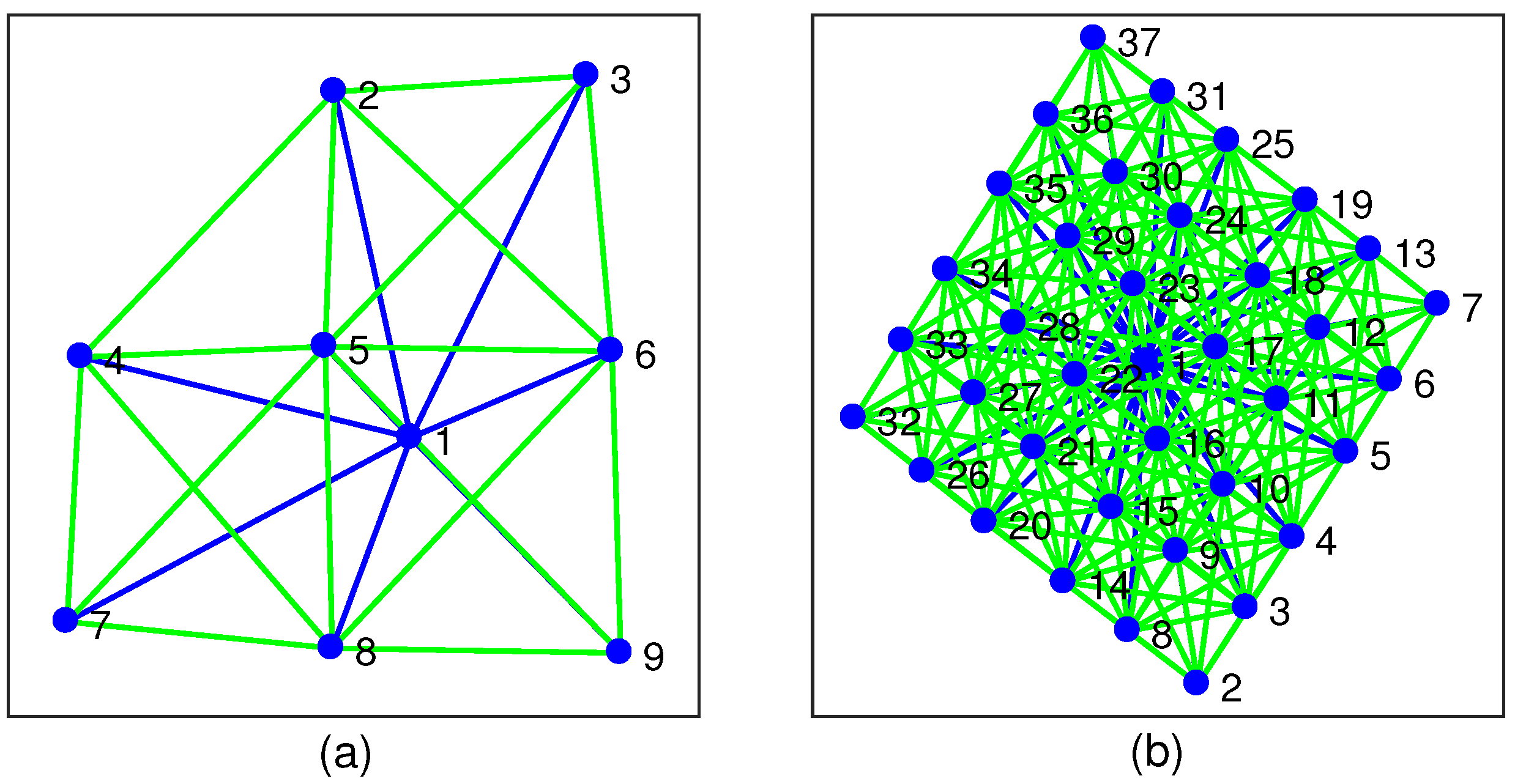
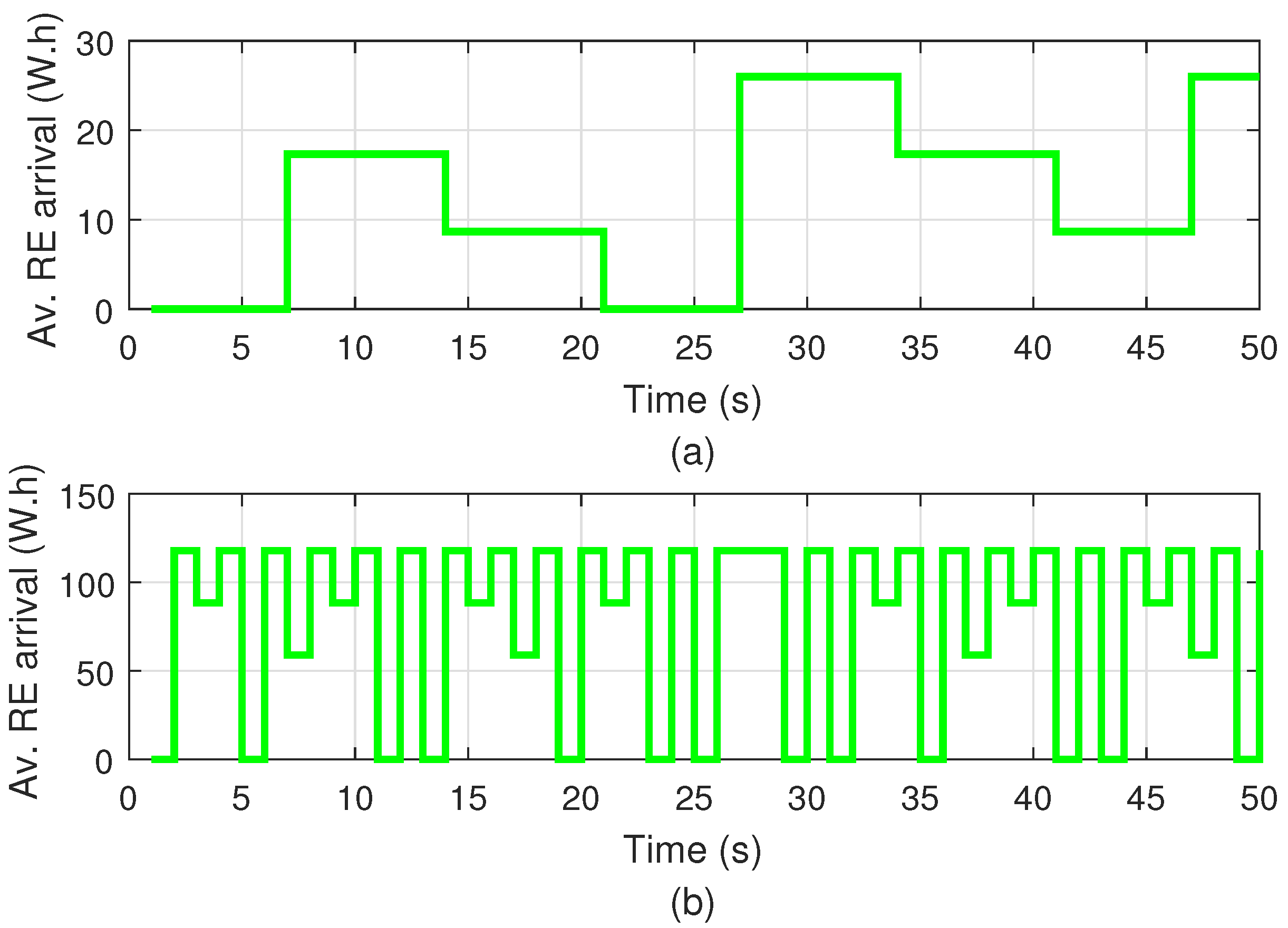

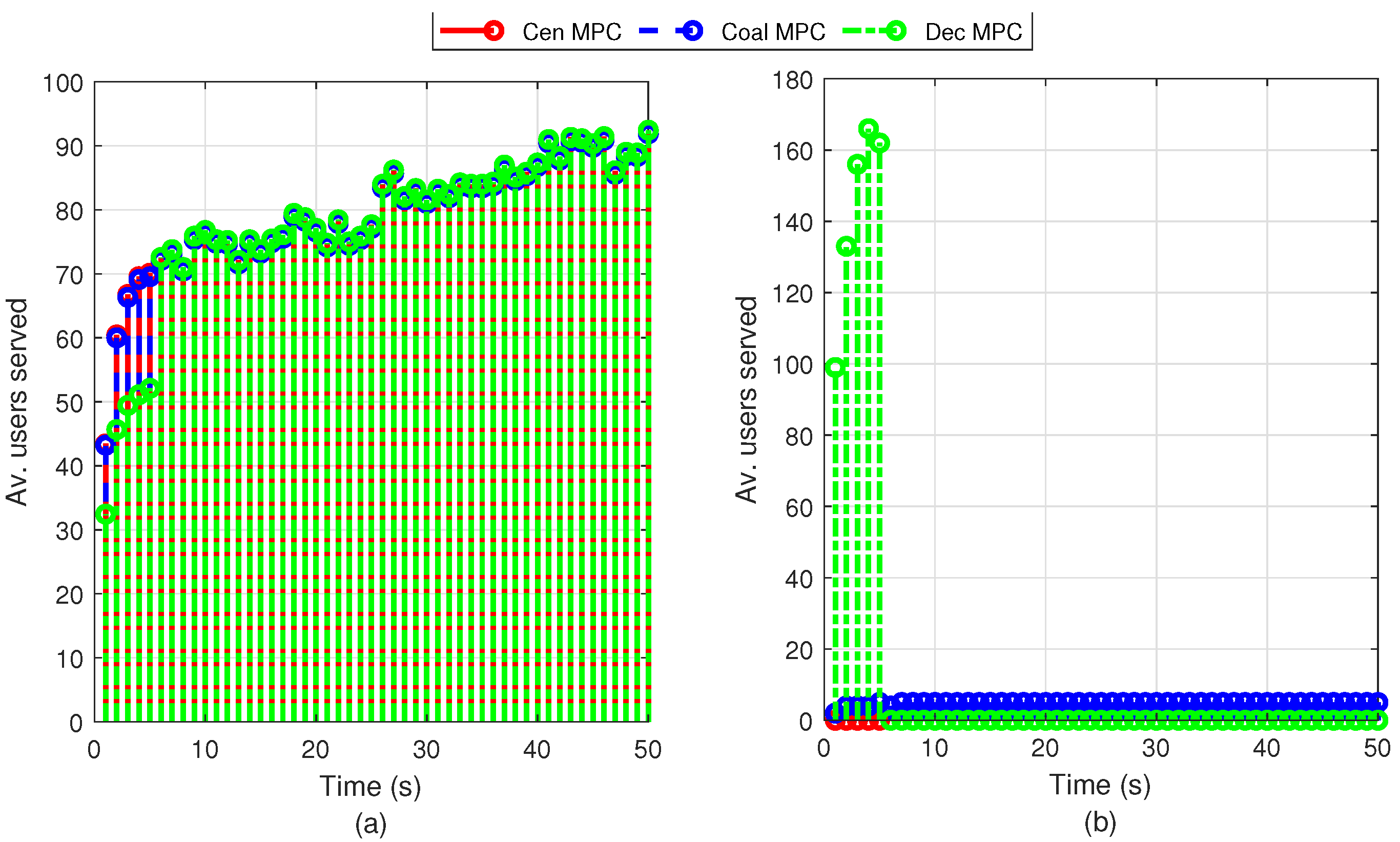
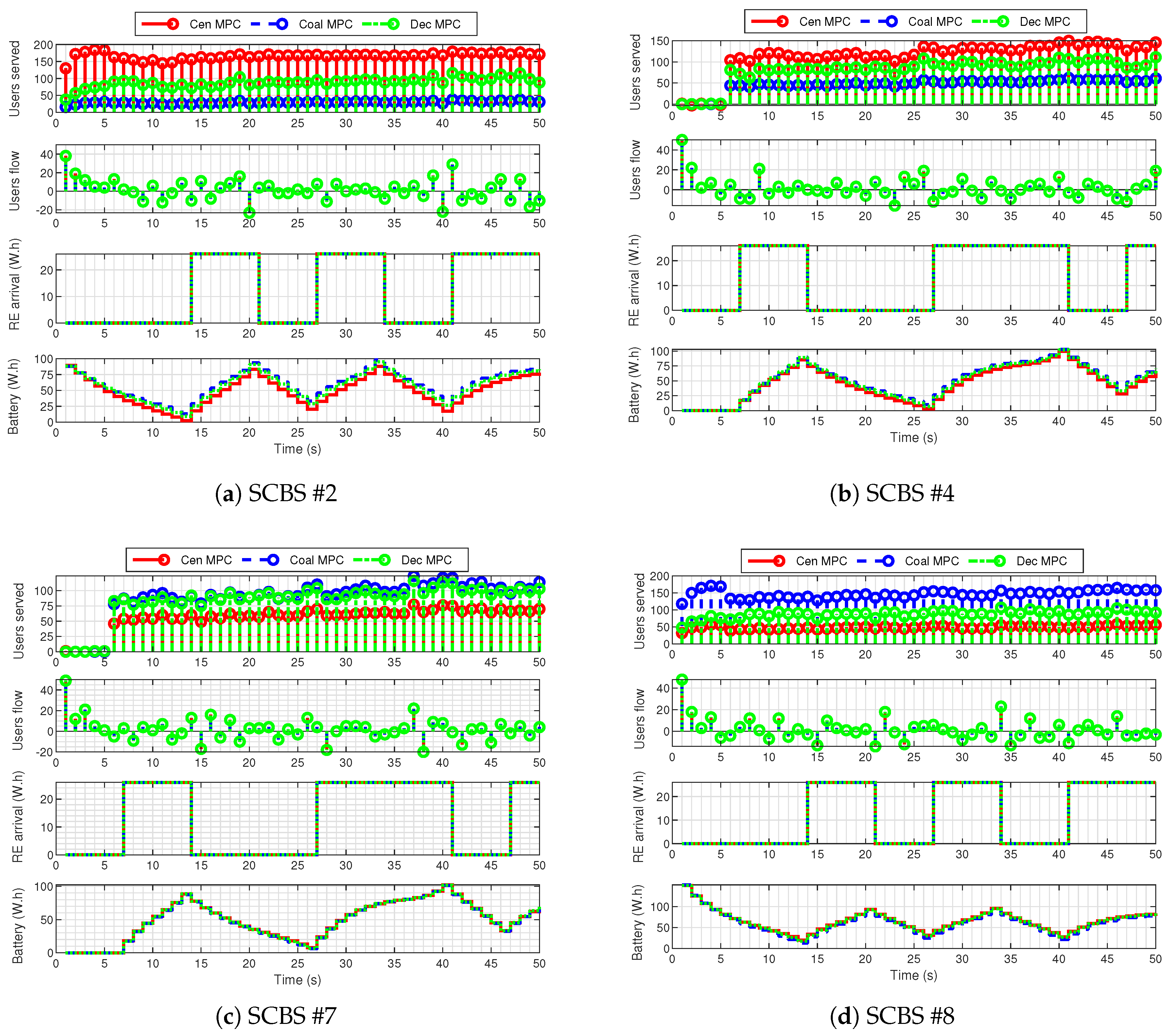
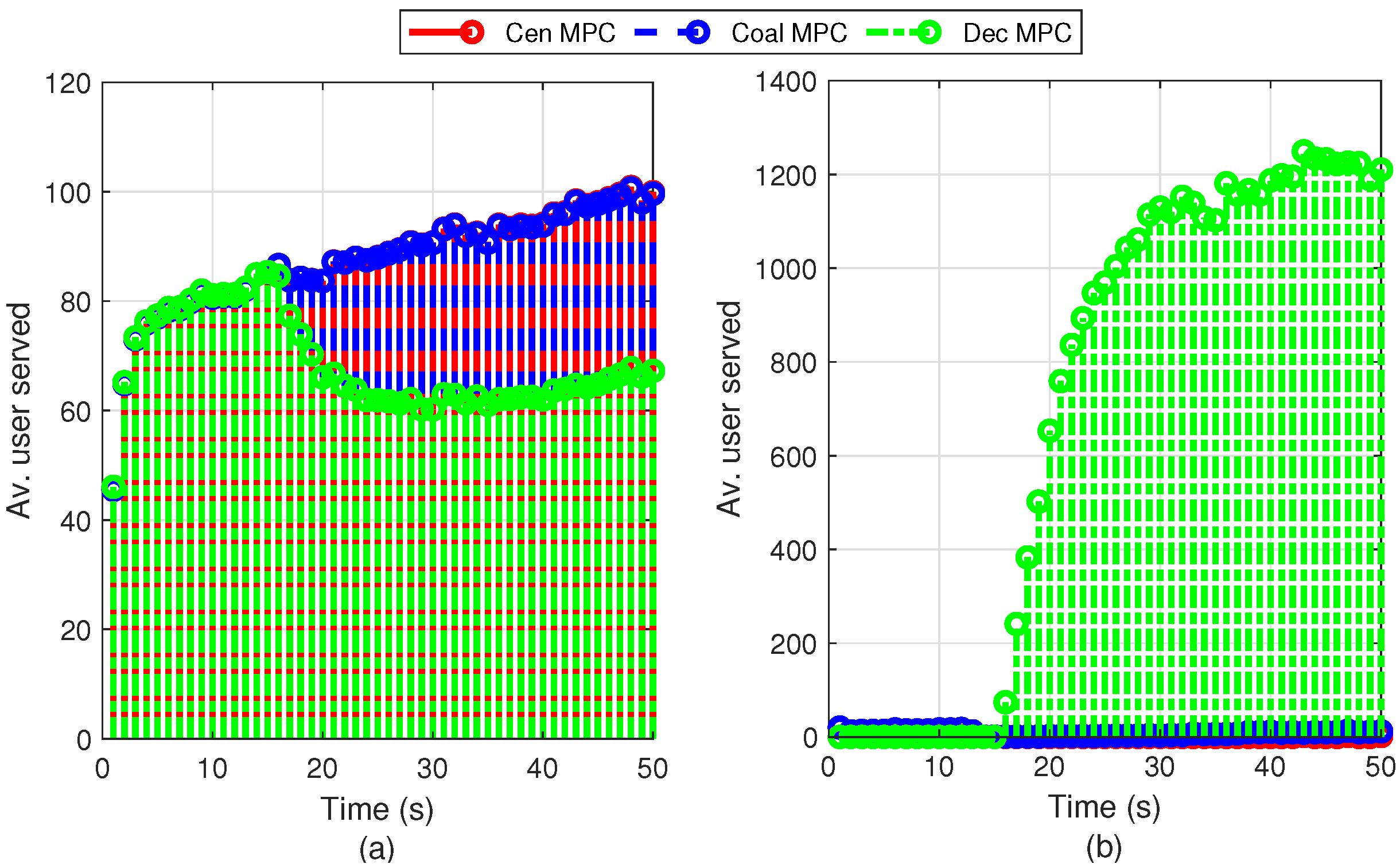
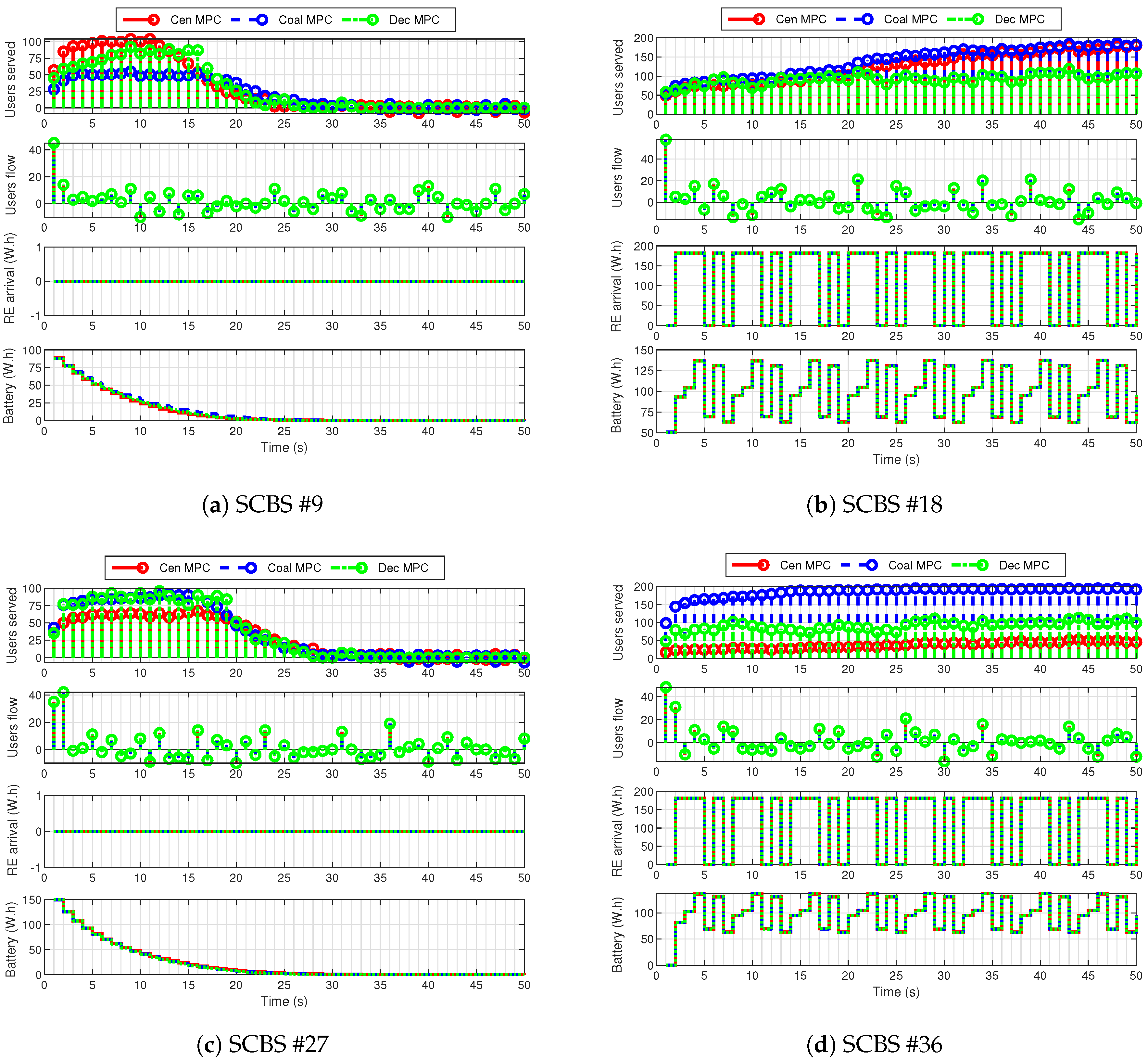
| Description | Value | Units | |
|---|---|---|---|
| Coverage area | |||
| Bandwidth of the LTE system | 20 | MHz | |
| Inter-site distance | 500 | m | |
| Transmission power of the MBS | 43 | dBm | |
| Transmission power of the SCBSs | 22 | dBm | |
| Static power consumption of the MBS | 130 | W.h | |
| Static power consumption of the SCBSs | W.h | ||
| Consumption slope of the MBS | – | ||
| Consumption slope of the SCBSs | – | ||
| Max. users flow between the BSs | 100 | – | |
| Max. users served by the SCBSs | 200 | – | |
| Max. battery capacity of the SCBSs | 200 | W.h | |
| Prediction horizon | 5 | – | |
| Upper layer execution | 10 | – | |
| Q | Weighting parameter | 100 | – |
| Weighting factor | – | ||
| Cost per cooperation link | – | ||
| - | Path loss between the MBS and z | Cost 231 model | – |
| - | Mobility model | Random walk | – |
| - | Mobility speed | 4 | km/h |
| Energy Management | User Experience | MPC Costs | ||||||
|---|---|---|---|---|---|---|---|---|
| Control Scheme | Grid Consumption (kW.h) | Grid Consumption Improvement (%) | Average Stored Energy (W.h) | Users Served (%) | Transmission Rate (Mbps) | |||
| Best-signal-level | − | − | − | − | ||||
| Energy-aware heuristic | − | − | − | |||||
| Centralized MPC | 130 | |||||||
| Decentralized MPC | ||||||||
| Coalitional MPC | ||||||||
| Energy Management | User Experience | MPC Costs | ||||||
|---|---|---|---|---|---|---|---|---|
| Control Scheme | Grid Consumption (kW.h) | Grid Consumption Improvement (%) | Average Stored Energy (W.h) | Users Served (%) | Transmission Rate (Mbps) | |||
| Best-signal-level | − | − | − | − | ||||
| Energy-aware heuristic | − | − | − | |||||
| Centralized MPC | ||||||||
| Decentralized MPC | ||||||||
| Coalitional MPC | ||||||||
Publisher’s Note: MDPI stays neutral with regard to jurisdictional claims in published maps and institutional affiliations. |
© 2020 by the authors. Licensee MDPI, Basel, Switzerland. This article is an open access article distributed under the terms and conditions of the Creative Commons Attribution (CC BY) license (http://creativecommons.org/licenses/by/4.0/).
Share and Cite
Masero, E.; Fletscher, L.A.; Maestre, J.M. A Coalitional Model Predictive Control for the Energy Efficiency of Next-Generation Cellular Networks. Energies 2020, 13, 6546. https://doi.org/10.3390/en13246546
Masero E, Fletscher LA, Maestre JM. A Coalitional Model Predictive Control for the Energy Efficiency of Next-Generation Cellular Networks. Energies. 2020; 13(24):6546. https://doi.org/10.3390/en13246546
Chicago/Turabian StyleMasero, Eva, Luis A. Fletscher, and José M. Maestre. 2020. "A Coalitional Model Predictive Control for the Energy Efficiency of Next-Generation Cellular Networks" Energies 13, no. 24: 6546. https://doi.org/10.3390/en13246546
APA StyleMasero, E., Fletscher, L. A., & Maestre, J. M. (2020). A Coalitional Model Predictive Control for the Energy Efficiency of Next-Generation Cellular Networks. Energies, 13(24), 6546. https://doi.org/10.3390/en13246546







